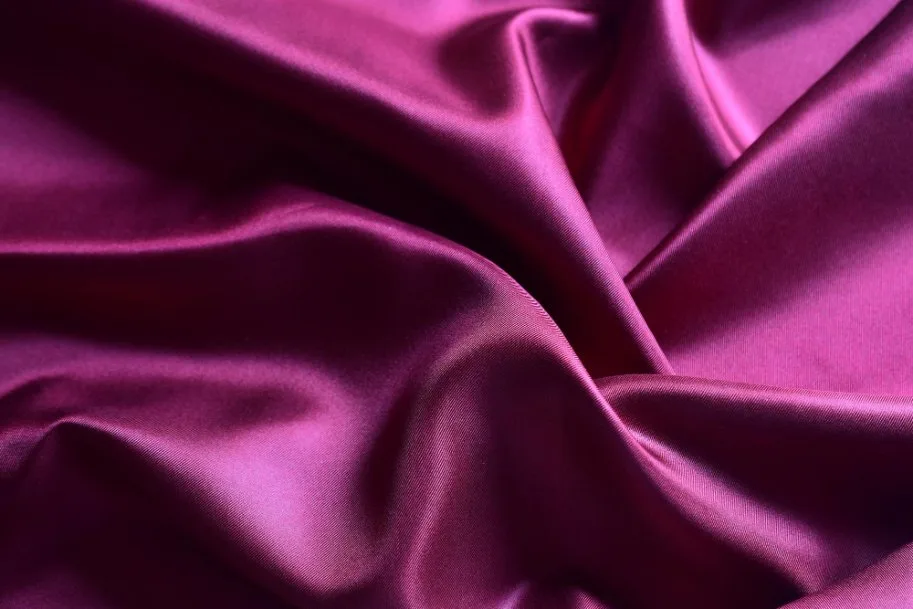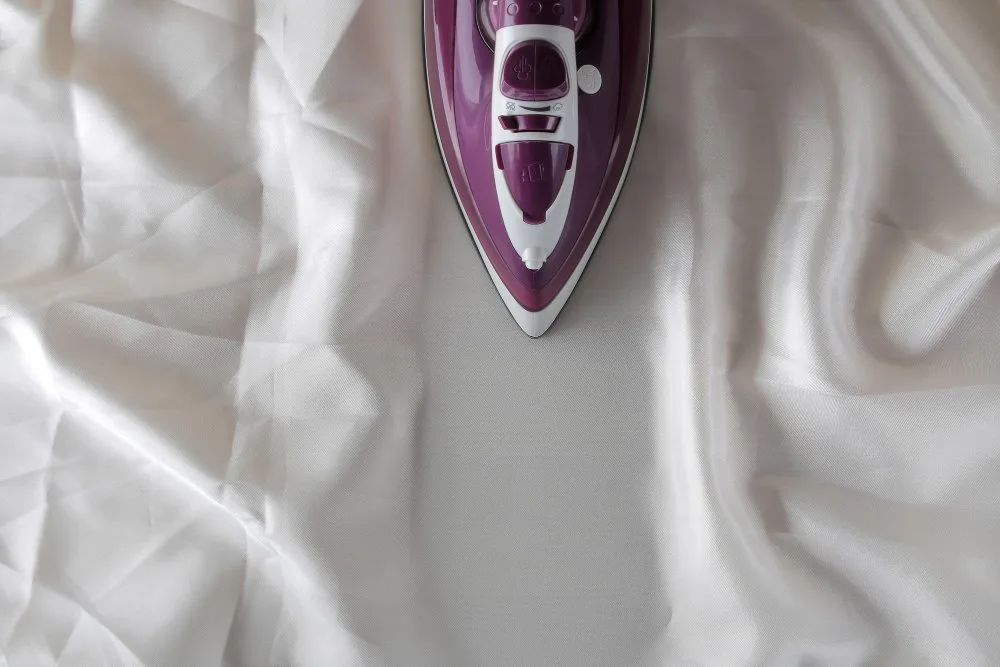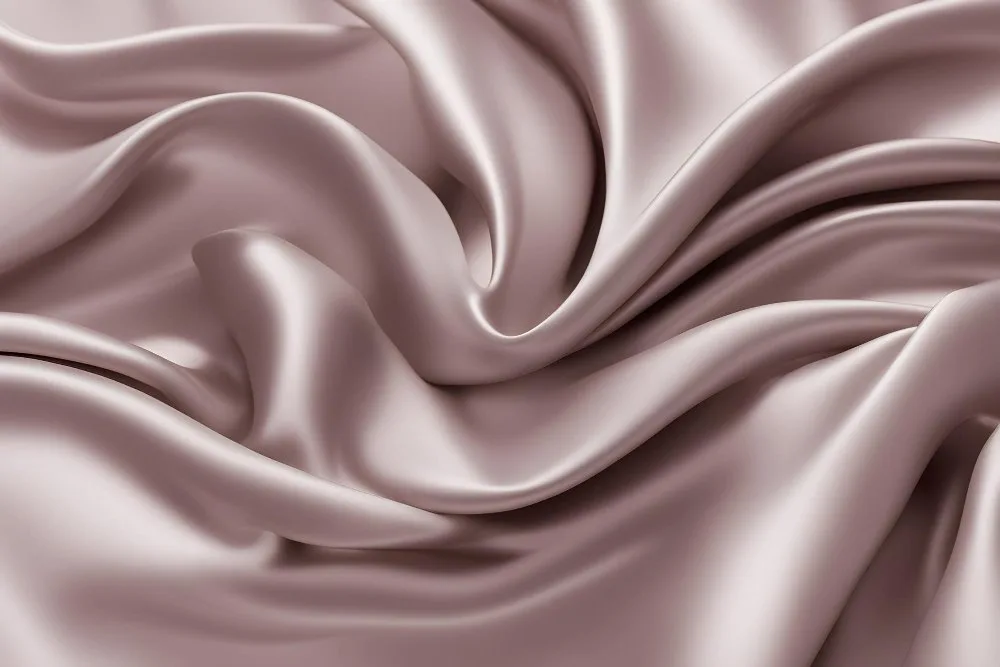Everything you need to know about the world’s finest natural fiber, from ancient origins to modern luxury
Table of Contents
- What Is Mulberry Silk?
- The 5,000-Year Journey: From Ancient China to Modern Bedrooms
- How Mulberry Silk Is Made
- Understanding Quality: Grades and Momme Weight
- Why Mulberry Silk Feels Different
- Benefits and Drawbacks of Mulberry Silk
- The Sustainability Question
- Mulberry Silk vs. Other Fabrics
- How to Care for Mulberry Silk
- Buying Guide: How to Spot Real Mulberry Silk
- Is Mulberry Silk Worth the Investment?
- Frequently Asked Questions
What Is Mulberry Silk?
Mulberry silk is a natural protein fiber produced by domesticated silkworms (Bombyx mori) that feed only on white mulberry leaves. This exclusive diet creates the longest, strongest, and most uniform silk fibers in the world. Unlike other types of silk fabric, mulberry silk has an even color, smooth texture, and natural sheen that makes it the gold standard for luxury textiles.
The silkworms spin their cocoons using a single, continuous thread that can stretch up to 900 meters (almost 3,000 feet). This incredible length means fewer breaks and joins in the final fabric, resulting in a smoother, more durable material. When you touch mulberry silk, you’ll notice it feels cool at first, then warms to match your body temperature. This happens because silk fibers have a unique triangular cross-section that reflects light and regulates heat.
Quick Facts About Mulberry Silk
- Made from 100% natural protein (fibroin)
- Contains 18 amino acids similar to human skin and hair
- Naturally hypoallergenic and resistant to dust mites
- One of the strongest natural fibers (stronger than steel of the same diameter)
- Biodegradable and returns to soil within 1-4 years
- Takes approximately 2,000-3,000 cocoons to make one pound of silk
Is Mulberry Silk Really Silk?
Yes, mulberry silk is 100% real silk. In fact, it’s considered the highest quality silk available. When people refer to “pure silk” or “real silk” in luxury products, they’re usually talking about mulberry silk. The confusion sometimes comes from the many synthetic alternatives on the market, like polyester satin, which mimic silk’s appearance but lack its natural properties.
The term “mulberry silk” specifically refers to silk from Bombyx mori silkworms. Other types of silk come from different silkworm species that eat different leaves, such as tussah silk (from wild silkworms that eat oak leaves) or eri silk (from castor plant-eating silkworms). All of these are technically silk, but mulberry silk stands apart because of its superior quality.
What’s the Difference Between 100% Silk and Mulberry Silk?
“100% silk” simply means the fabric contains only silk fibers with no synthetic blends. However, it doesn’t tell you what type of silk or its quality. A product labeled “100% silk” could be made from mulberry silk, tussah silk, or any other silk variety. Mulberry silk, on the other hand, is both a type indicator and a quality marker.
When you see “100% mulberry silk” on a label, you’re getting two pieces of information: the fabric is pure silk (no blends) AND it comes from the specific silkworms that produce the finest quality. This is why you should always look for both terms when shopping for premium silk products.
The 5,000-Year Journey: From Ancient China to Modern Bedrooms
The story of mulberry silk begins around 2700 BCE in ancient China with a legend about Empress Leizu. According to the tale, a silkworm cocoon fell into her tea while she sat under a mulberry tree. As the hot liquid loosened the cocoon, she watched a shimmering thread unravel. Curious, she began experimenting with these threads and eventually discovered how to weave them into fabric. While this story may be more myth than fact, archaeological evidence confirms that silk production in China dates back at least 5,000 years.
For centuries, the Chinese kept silk production a closely guarded secret. Anyone caught smuggling silkworms or revealing production techniques faced execution. This monopoly made silk incredibly precious. It was used as currency, reserved for royalty, and became the foundation of China’s economy. By 1000 BCE, China began trading silk beyond its borders, creating the famous Silk Road. This network of trade routes stretched from China to the Mediterranean, connecting civilizations and cultures for over 1,500 years.
The secret of silk production finally escaped China around 550 AD when, according to legend, two monks smuggled silkworm eggs out of the country hidden in hollow bamboo canes. From there, silk production spread to Byzantium, Persia, and eventually Europe. By the 15th century, Italy and France had become major silk producers, with cities like Lyon becoming famous for their silk weaving. Today, China still produces about 54% of the world’s silk, followed by India at 14%.
How Mulberry Silk Is Made
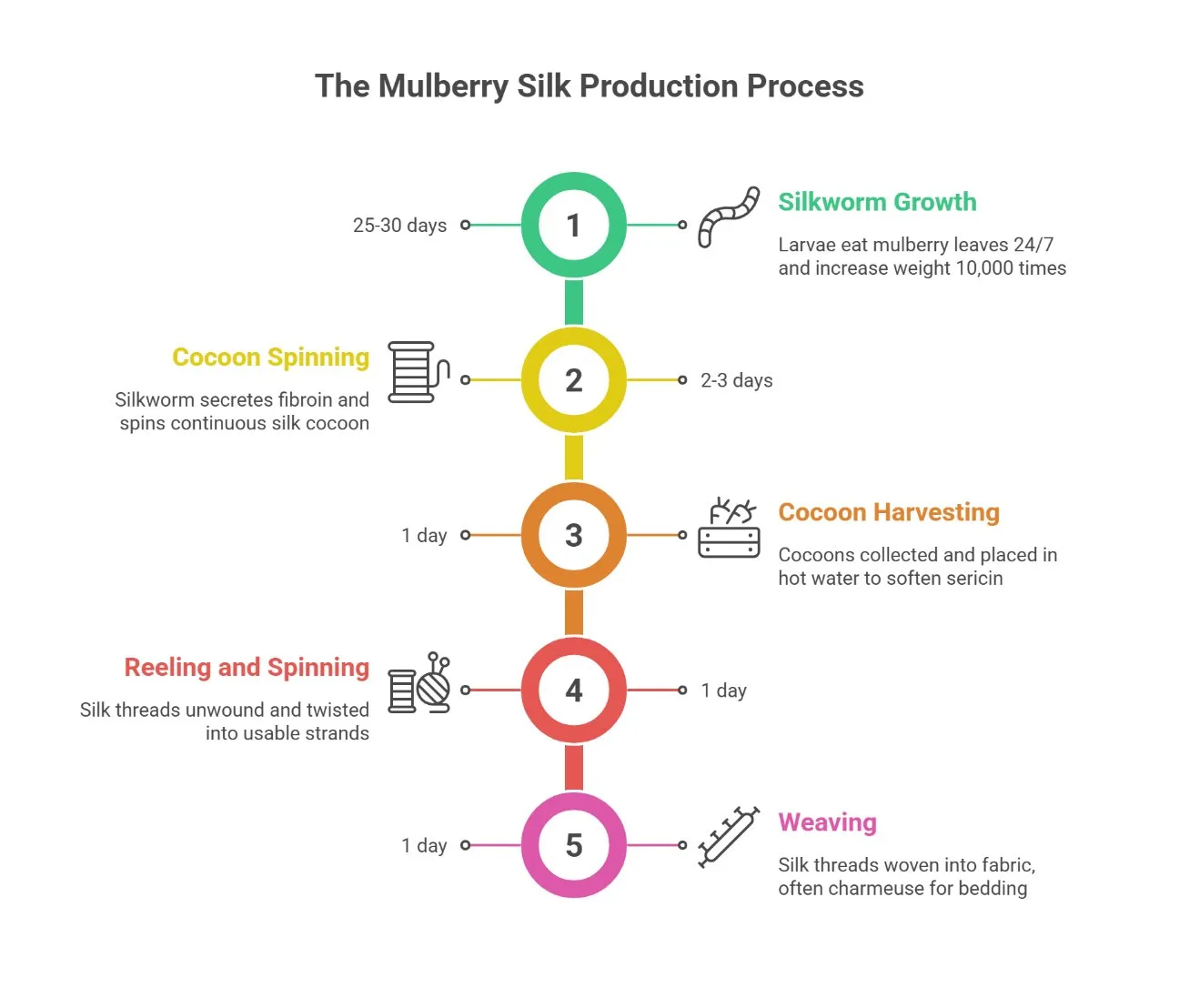
The process of creating mulberry silk hasn’t changed much in thousands of years. It’s called sericulture, and it’s a delicate balance of farming, timing, and craftsmanship. Here’s how it works:
- Cultivating Mulberry Trees: White mulberry trees (Morus alba) are grown specifically to feed silkworms. These trees need minimal pesticides and grow well in various climates, making them relatively sustainable.
- Raising Silkworms: A female moth lays around 500 eggs. After hatching, the tiny larvae eat continuously for about 25-30 days. During this time, they consume mulberry leaves 24/7 and increase their body weight by roughly 10,000 times.
- Spinning Cocoons: When fully grown, each silkworm begins spinning its cocoon. It secretes a liquid protein called fibroin from special glands. This liquid hardens when it contacts air, forming a continuous silk thread. It takes 2-3 days for a silkworm to complete its cocoon.
- Harvesting (Reeling): Before the moth emerges and breaks the thread, cocoons are collected. They’re placed in hot water to soften the sericin (a natural gum that holds the cocoon together). This process, while necessary for quality silk production, also ends the silkworm’s life, which raises ethical questions we’ll discuss later.
- Reeling and Spinning: Workers carefully unwind the cocoon thread. Since each thread is very fine, several strands (typically 4-8) are twisted together to create a usable silk thread.
- Weaving: The silk threads are woven into fabric using various techniques. Charmeuse weave is most common for bedding and creates that signature shiny surface on one side.
The entire process is labor-intensive and requires significant skill. This partly explains why mulberry silk remains expensive even with modern production methods. You can learn more about the sericulture process from the Smithsonian National Museum of American History.
The silk road was a significant development in the history of silk production and trade. You can read more about silk in antiquity from World History Encyclopedia, which provides detailed information about ancient silk production and trade routes.
Understanding Quality: Grades and Momme Weight
Not all mulberry silk is created equal. Two key measurements determine quality: grade and momme weight. Understanding these will help you make smarter purchases and avoid overpaying for inferior silk.
Silk Grades Explained (6A to C)
Raw silk is graded according to China’s GBT 1797-2008 Raw Silk Quality Standards. The grading system ranges from 6A (highest) through 5A, 4A, 3A, 2A, A, B, C, and down to lower grades. These grades are determined by testing 10 specific factors including fiber length, size deviation, evenness, cleanness, neatness, and tensile strength.
Silk Grade Breakdown
Grade 6A (The Best – Only 5-10% of Production)
The absolute finest raw silk available. Features exceptionally long fibers (over one mile in a single uninterrupted thread), pearl-white color, natural luminous shine, minimal defects, and superior strength. Used in the highest-quality bedding, wedding gowns, and luxury garments.
Grade 5A-4A (Excellent Quality)
Very high quality with long fibers and good uniformity. Slight variations in color or minor imperfections may be present. Still feels incredibly smooth and lasts for years. Commonly used in quality silk products.
Grade 3A-A (Good Quality)
Decent quality silk with shorter fiber lengths. May have slight irregularities in texture. Suitable for many applications but won’t have the same longevity or luxurious feel as higher grades.
Grade B (Fair Quality)
Contains shorter lengths of silk with more clumps and air pockets. Yellowish tint instead of pearl white. Rougher texture and less natural shine. Commonly used in fashion garments like sarees and kaftans.
Grade C (Low Quality)
The innermost layer of silk closest to the cocoon. Has a yellowish appearance with brown dots. Feels similar to cotton fabric with a rough texture. Used mainly as filling for pillows or duvets where it won’t touch skin directly.
Important Note About Grades
These grades apply only to raw silk before processing. Once silk is woven into finished products, you cannot independently verify the grade. This is why buying from reputable brands with certifications (like OEKO-TEX Standard 100) matters so much. Many companies claim “6A grade” in marketing, but you’re ultimately relying on their integrity.
What Is Momme Weight?
While grade tells you about fiber quality, momme (pronounced “moe-may” and abbreviated as “mm”) tells you about fabric density and weight. Think of it like thread count for cotton, but not exactly the same. One momme equals 4.34 grams per square meter of fabric.
Here’s why momme matters: Silk threads are incredibly thin (about 1/10th the thickness of human hair), so traditional thread count measurements would be impractically high. Momme gives us a practical way to compare silk fabrics.
| Momme Weight | Uses | Characteristics | Best For |
|---|---|---|---|
| 8-12mm | Lightweight scarves, linings | Very light, delicate, may be somewhat transparent | Accessories, warm weather items |
| 16-19mm | Clothing, light bedding | Breathable, elegant, more affordable | Garments, summer sleepwear, budget-friendly pillowcases |
| 22mm (Sweet Spot) | Pillowcases, sheets, quality sleepwear | Perfect balance of durability, comfort, and luxury feel | Regular use bedding, daily wear items |
| 25-30mm (Premium) | Luxury bedding, high-end fashion | Extremely durable, substantial feel, maximum luxury | Investment pieces, colder climates, long-term use |
For most applications, 22mm strikes the perfect balance. It’s durable enough for regular washing, substantial enough to feel luxurious, yet not so heavy that it becomes uncomfortable. Many quality brands use 22mm for pillowcases and 19-25mm for other products depending on the intended use.
📊 Not Sure Which Momme Weight to Choose?
Our interactive momme weight guide helps you select the perfect silk weight based on your specific needs, climate, and budget. Get personalized recommendations in seconds.
Use the Momme Weight Guide →Important: Grade and momme are independent measurements. You could have 6A grade silk at 19mm or 25mm. The grade tells you about fiber quality; momme tells you about how much silk is used in the fabric. For the best products, look for both high grade (6A or 5A) AND appropriate momme weight (19-25mm for bedding).
Why Mulberry Silk Feels Different
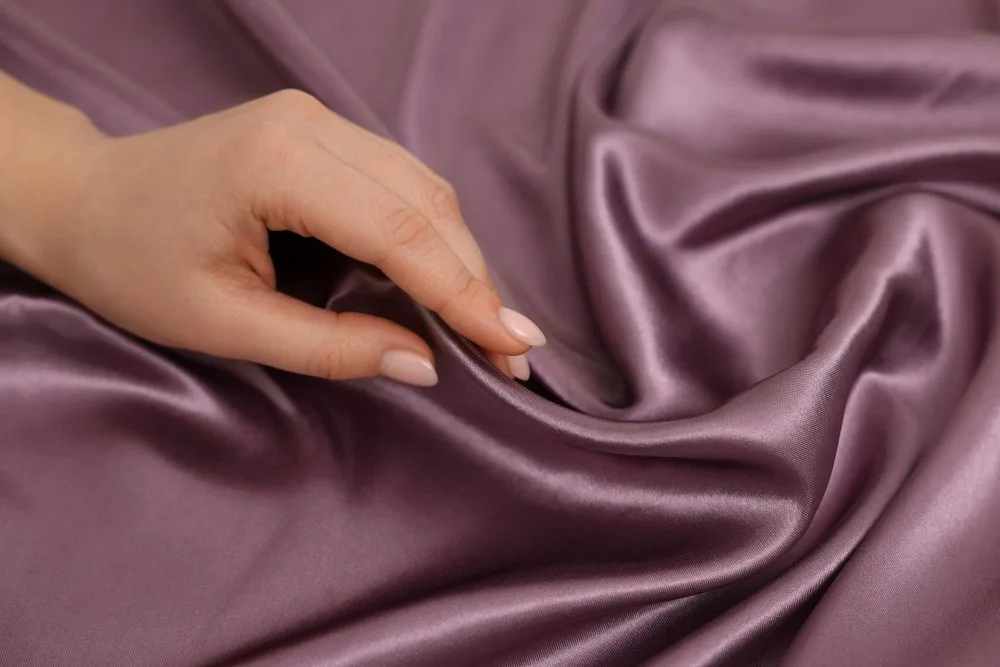
What Does Mulberry Silk Feel Like?
The first time you touch quality mulberry silk, you’ll understand why people pay premium prices. It feels impossibly smooth, almost liquid-like, as if your hand is gliding across water. The surface is completely friction-free, which is exactly why it’s so good for hair and skin. Unlike cotton that can feel rough or “grabby,” silk has virtually no resistance.
Temperature-wise, silk feels cool when you first touch it, then quickly warms to match your body heat. This happens because of silk’s hollow fiber structure, which allows it to absorb up to 30% of its weight in moisture without feeling damp. The triangular cross-section of silk fibers also creates tiny air pockets that provide natural insulation.
Quality mulberry silk has a subtle, natural sheen that catches light beautifully. It’s not a harsh, plastic-like shine (which you might see in cheaper satins), but rather a soft, luminous glow. The fabric drapes elegantly and has a slight weight to it, especially at higher momme weights.
The Science Behind the Feel
What makes mulberry silk unique at a molecular level? It’s all about the protein structure. Silk is composed primarily of fibroin, a protein that contains 18 amino acids. These amino acids are remarkably similar to those found in human skin and hair, which is partly why silk is so compatible with our bodies.
The protein structure also naturally contains sericin, which has several benefits:
- Anti-bacterial properties: Sericin naturally resists bacteria, mold, and fungus
- Hypoallergenic: Repels dust mites and common allergens
- Moisture retention: Helps skin and hair stay hydrated
- Anti-aging potential: Some research suggests sericin may help reduce fine lines (though more studies are needed)
Benefits and Drawbacks of Mulberry Silk
Let’s be honest about both the advantages and limitations of mulberry silk. No fabric is perfect for everyone or every situation.
Advantages of Mulberry Silk
- Hair Benefits: The smooth surface prevents friction, reducing breakage, split ends, and frizz. Particularly good for curly, color-treated, or damaged hair.
- Skin Health: Doesn’t absorb moisture from skin like cotton does. May help reduce sleep creases and morning face lines. Gentle on sensitive or acne-prone skin.
- Temperature Regulation: Keeps you cool in summer, warm in winter. Naturally breathable and moisture-wicking.
- Hypoallergenic: Naturally resistant to dust mites, mold, mildew, and common allergens. Great for people with allergies or asthma.
- Durability: Despite feeling delicate, high-quality mulberry silk is remarkably strong. Can last for years with proper care.
- Odor Resistance: Naturally odor-free and doesn’t need frequent washing.
- Biodegradable: Returns to soil naturally, unlike synthetic alternatives.
- Luxurious Feel: There’s simply no substitute for how silk feels against your skin.
Disadvantages of Mulberry Silk
- High Cost: Quality mulberry silk is expensive. Expect to pay $50-150 for a good pillowcase, $300-800 for sheets.
- Requires Special Care: Hand washing or delicate machine cycles only. No hot water, no harsh detergents, no dryer.
- Stains Easily: Water spots and stains can be difficult to remove. Need to act quickly when spills occur.
- Delicate Nature: Can snag on rough surfaces, jewelry, or nails. Needs gentle handling.
- Sun Sensitivity: Direct sunlight can cause colors to fade. Must be dried away from sun exposure.
- Not Vegan: Production involves silkworms and raises ethical concerns for some people.
- Can Feel Slippery: Some people find silk too slippery for comfortable sleep, especially on silk sheets.
- May Feel Cool: The initial coolness can be uncomfortable for people who are always cold.
Is 100% Mulberry Silk Good for Hair?
Absolutely. The hair benefits of mulberry silk are one of the main reasons people invest in silk pillowcases. Here’s what actually happens: Regular pillowcases create friction as you move during sleep. This friction causes the hair cuticle to lift and break, leading to split ends, frizz, and dullness. Cotton, in particular, has a rough texture at the microscopic level that acts like velcro on your hair.
Silk’s smooth surface eliminates this friction. Your hair glides across the pillowcase instead of catching and pulling. This is particularly important for:
- Curly or textured hair that’s prone to tangling
- Color-treated hair that needs protection from damage
- Fine hair that breaks easily
- Anyone trying to grow their hair longer
- People with hair loss concerns
Additionally, because silk doesn’t absorb moisture like cotton, your hair’s natural oils and any treatments you’ve applied stay in your hair instead of being pulled into the pillowcase. Many people notice their hair looks better and needs less styling in the morning after switching to silk.
Is Mulberry Silk Better Than Cotton?

It depends on what matters most to you. Cotton and synthetic fabrics each have different properties, and the “better” choice depends on your priorities and budget.
| Factor | Mulberry Silk | High-Quality Cotton |
|---|---|---|
| Price | $50-150 per pillowcase | $15-50 per pillowcase |
| Hair Protection | Excellent – minimal friction | Moderate – some friction |
| Skin Moisture | Retains moisture in skin | Absorbs moisture from skin |
| Temperature | Adapts to body temp | Can trap heat |
| Durability | Strong but delicate | Very durable, wash-friendly |
| Care | Special care required | Easy – machine wash and dry |
| Hypoallergenic | Naturally resistant to allergens | Can harbor dust mites |
| Best For | Luxury, hair/skin care, allergies | Easy care, durability, budget |
If you want the absolute best for your hair and skin, have allergies, or simply enjoy luxury, silk wins. If you need easy-care bedding that can withstand frequent washing and you’re on a budget, cotton is the practical choice. Some people even do both: silk pillowcases for hair and skin benefits, cotton sheets for easy maintenance. Want to see a detailed side-by-side comparison? Try our interactive fabric comparison tool.
The Sustainability Question
The environmental impact of mulberry silk is complex and deserves an honest discussion. Silk has both advantages and concerns from a sustainability perspective.
The Eco-Friendly Aspects
Mulberry silk production has several environmental benefits:
- Low Water Usage: Mulberry trees and silk production use significantly less water than cotton cultivation. A silk shirt requires much less water to produce than a cotton one.
- Minimal Pesticides: Mulberry trees grow easily without heavy pesticide use. The trees also help prevent soil erosion and absorb CO2.
- Biodegradable: Pure silk completely breaks down naturally in 1-4 years, unlike synthetic fabrics that persist for hundreds of years.
- Energy Efficiency: Traditional silk production uses less energy than creating synthetic fibers from petroleum.
- Longevity: Quality silk lasts for years, reducing the need for frequent replacements and overall consumption.
- No Toxic Chemicals: Unlike synthetic fabrics, silk doesn’t require petroleum-based materials or release microplastics into waterways.
The Ethical Concerns
However, there are legitimate concerns about silk production:
- Silkworm Treatment: Traditional silk production requires boiling cocoons with silkworms still inside to get continuous thread. This ends thousands of lives for each pound of silk.
- Land Use: Large-scale silk production requires significant land for mulberry cultivation.
- Chemical Processing: Some silk finishing processes use chemicals, though this varies by manufacturer.
- Carbon Footprint: A 2017 study found silk production has a relatively high carbon footprint due to energy use in processing.
Peace Silk: An Alternative?
For those concerned about silkworm welfare, “peace silk” (also called ahimsa silk) allows moths to emerge from cocoons before harvesting. However, this creates shorter fibers and a different texture. Peace silk is less smooth, less lustrous, and doesn’t have all the same properties as traditional mulberry silk. It’s also more expensive due to lower yields.
Making Sustainable Choices
If you want to minimize environmental impact while choosing silk:
- Look for GOTS (Global Organic Textile Standard) or OEKO-TEX certifications
- Choose brands that are transparent about their production methods
- Buy quality pieces that will last for years rather than cheap silk that needs frequent replacement
- Consider peace silk if animal welfare is your priority
- Properly care for your silk to extend its lifespan
- When items reach end-of-life, compost them or repurpose them rather than throwing them away
Mulberry Silk vs. Other Fabrics
Is Mulberry Silk Better Than Satin?

This comparison confuses many people because “silk” and “satin” aren’t opposite categories. Let’s clear this up: Silk is a fiber (a material), while satin is a weave (a construction method). You can have silk satin, which is silk woven in a satin weave pattern. You can also have polyester satin or nylon satin, which are synthetic fibers woven in the satin style.
When people ask “silk vs. satin,” they usually mean “mulberry silk vs. polyester satin.” Here’s how they compare:
| Feature | Mulberry Silk | Polyester Satin |
|---|---|---|
| Material | Natural protein fiber | Petroleum-based synthetic |
| Feel | Cool, smooth, breathable | Slippery but can feel clammy |
| Temperature | Regulates body heat naturally | Traps heat, less breathable |
| Hair Benefits | Excellent friction reduction, retains hair moisture | Some friction reduction, no moisture benefits |
| Skin Benefits | Hypoallergenic, naturally anti-bacterial | Can cause irritation, no natural benefits |
| Durability | Strong but needs gentle care | Durable but prone to snagging |
| Care | Hand wash or delicate cycle | Easy machine wash |
| Environmental Impact | Biodegradable, sustainable | Non-biodegradable, releases microplastics |
| Price | $50-150 per pillowcase | $10-30 per pillowcase |
If you’re choosing between real mulberry silk and polyester satin, silk offers superior benefits for hair, skin, and the environment. However, polyester satin costs much less and requires less careful maintenance. For those on a tight budget, polyester satin is better than regular cotton pillowcases, but it can’t match silk’s natural properties. You can learn more about silk fabric properties to understand these differences better.
⚖️ Compare Silk with Other Fabrics
Still deciding between mulberry silk, cotton, satin, or other fabrics? Our interactive fabric comparison tool lets you compare properties, benefits, costs, and care requirements side-by-side to make the best choice for your needs.
Try the Comparison Tool →Mulberry Silk vs. Other Silk Types
What’s the Difference Between Mulberry Silk and Non-Mulberry Silk?
Several types of silk exist, each from different silkworm species eating different plants. Here’s how mulberry silk compares:
| Silk Type | Source | Characteristics | Best Uses |
|---|---|---|---|
| Mulberry Silk | Bombyx mori (domesticated, mulberry leaves) | Longest fibers, smoothest texture, uniform pearl-white color, natural sheen | Luxury bedding, high-end fashion, premium accessories |
| Tussah (Tussar) Silk | Wild silkworms (oak leaves) | Shorter fibers, coarser texture, natural golden/beige color, rustic look | Textured fabrics, ethnic wear, casual clothing |
| Eri Silk | Samia ricini (castor plant) | Soft but not smooth, wool-like texture, ethical (moth emerges first) | Ethical fashion, winter wear, sustainable products |
| Muga Silk | Antheraea assamensis (native to Assam, India) | Natural golden color, durable, glossy, rare | Traditional garments, special occasion wear |
Which Is Better: Tussah Silk or Mulberry Silk?
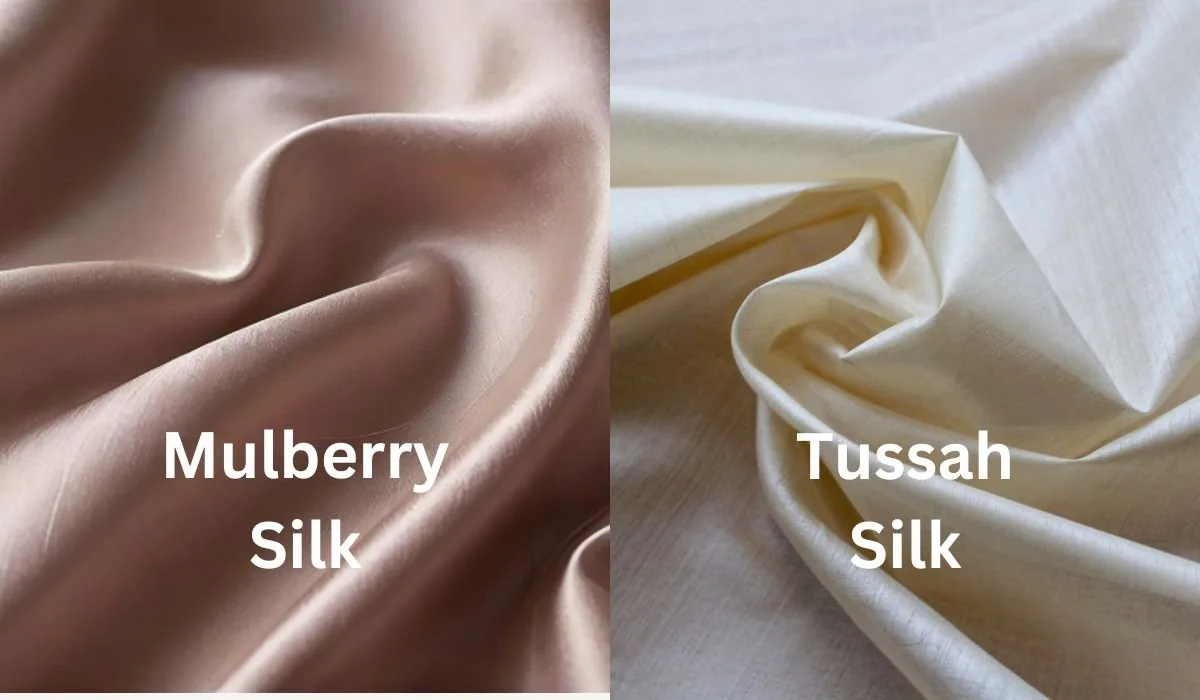
For smoothness, uniformity, and luxury feel, mulberry silk wins every time. Tussah silk has its place in textured fabrics and casual wear, but it can’t match mulberry silk’s softness or sheen. Tussah silk is coarser because wild silkworms have irregular diets and aren’t bred specifically for silk quality. If you’re buying silk pillowcases or bedding for hair and skin benefits, stick with mulberry silk. Tussah silk won’t provide the same friction-free surface.
What Country Does Mulberry Silk Come From?
While mulberry silk originated in China around 5,000 years ago, it’s now produced in several countries. China remains the largest producer, accounting for about 54% of global silk production. India produces another 14%, followed by Uzbekistan, Thailand, Brazil, and several other countries. The quality can vary by region, but China and India continue to produce the highest grades of mulberry silk due to thousands of years of expertise and ideal climate conditions for mulberry cultivation.
How to Care for Mulberry Silk
Proper care makes the difference between silk that lasts for years and silk that gets ruined after a few washes. The good news is that once you understand the basics, caring for silk isn’t difficult. You just need to be gentle and avoid a few common mistakes.
🧼 Get Personalized Silk Care Instructions
Not sure exactly how to care for your specific silk item? Our silk care calculator provides customized washing, drying, and storage instructions based on your silk type, momme weight, and color. Takes the guesswork out of silk care.
Get Care Instructions →How Often Should You Wash Mulberry Silk?
Wash silk pillowcases every 1-2 weeks, the same as you would regular pillowcases. Silk sheets can be washed every 1-2 weeks as well. Silk clothing depends on use, but generally after 3-4 wears unless there’s visible dirt or odor. Don’t overwash silk because each wash does cause some wear, even when done correctly.
Can You Wash Mulberry Silk?
Yes, you can absolutely wash mulberry silk at home. Despite what some people think, silk doesn’t require dry cleaning (which can actually be harsh on the fibers). You have two options: hand washing or machine washing on a delicate cycle. Both work well when done correctly.
How to Clean 100% Mulberry Silk (Step-by-Step)
Watch this step-by-step video guide on properly washing silk pillowcases and sheets, both by hand and in a washing machine.
Hand Washing Method (Recommended)
- Fill a clean basin with cool or lukewarm water (below 30°C/86°F). Hot water can damage silk fibers and cause shrinkage.
- Add a small amount of silk-specific detergent (or a gentle, pH-neutral detergent without enzymes). Enzyme detergents break down proteins, which silk is made from. Good options include Heritage Park Silk & Wool Wash or any detergent labeled for delicates.
- Turn your silk item inside out before washing. This protects the shiny side from any potential friction.
- Submerge the silk and gently swish it around for 3-5 minutes. Don’t scrub, twist, or wring. Just move it gently through the water.
- Rinse thoroughly with clean, cool water until all detergent is removed. You may need to rinse 2-3 times.
- Gently squeeze out excess water by pressing the silk between your hands. Never twist or wring.
- Roll the silk in a clean, white towel and press to absorb more water. Don’t use colored towels that might transfer dye.
- Hang to air dry away from direct sunlight or lay flat on a clean, dry towel. Sunlight can cause colors to fade.
Machine Washing Method
If you choose to machine wash (which is fine for quality silk), follow these steps:
- Place silk items in a mesh laundry bag. This protects them from friction with other items and the machine drum.
- Use a delicate or silk cycle with cold water (30°C/86°F or below).
- Use silk-specific or gentle detergent without enzymes. Add only a small amount.
- Wash silk items alone or only with other silk items. Don’t mix with cotton, denim, or other fabrics.
- Remove immediately when cycle finishes and follow the same drying instructions as hand washing.
Can Mulberry Silk Get Wet?
Yes, silk can get wet. In fact, you wash it with water. However, silk is more delicate when wet, so you need to handle it gently. Don’t panic if you spill water on silk. Just blot it gently with a towel and let it air dry. Water spots can sometimes leave marks on silk, especially darker colors, so act quickly when spills happen.
What Happens to Mulberry Silk in the Dryer?
Never put silk in the dryer. The heat will damage the fibers, cause shrinkage, and create white streaks or spots. The tumbling action can also cause excessive friction. If you accidentally put silk in the dryer, check for shrinkage and inspect for damage. If it still looks and feels okay, you may have gotten lucky, but don’t risk it again.
Why Can’t You Put Silk Pillowcases in the Dryer?
Heat and silk don’t mix. Silk is a protein fiber (similar to your hair), and just like heat can damage your hair, it damages silk. High temperatures can:
- Break down the protein structure
- Cause shrinkage (sometimes up to 10-20%)
- Create permanent white streaks or discoloration
- Weaken the fibers, reducing lifespan
- Remove the natural sheen
The tumble action adds friction that rough up the smooth silk surface. Always air dry silk items.
Why Do My Silk Sheets Feel Rough?
If your silk sheets feel rough, several things could have happened:
- Residue buildup: Using too much detergent or fabric softener (which you should never use on silk) can leave residue
- Wrong detergent: Enzyme detergents can break down silk fibers over time
- Hot water damage: Washing in water that’s too hot can damage the smooth surface
- Dryer damage: Even one cycle in the dryer can permanently rough up silk
- Low quality silk: Grade B or C silk naturally has a rougher texture
- Age and wear: Even quality silk eventually shows wear
To fix rough silk, try washing it again with proper silk detergent and cool water. If the damage is from heat or improper detergent use, it may be permanent.
Does Mulberry Silk Smell?
Quality mulberry silk is naturally odorless. If your silk has a smell, it’s usually from:
- Chemical processing or dyes used in manufacturing (should fade after first wash)
- Packaging materials (also fades quickly)
- Low-grade silk that hasn’t been processed properly
- Mildew from improper storage
Real mulberry silk should not have a persistent strong smell. If it does, this could indicate low quality or improper production methods.
Additional Care Tips
- Stain Removal: Act fast. Blot (don’t rub) spills immediately with cold water. For tough stains, apply a tiny bit of silk detergent directly to the spot, gently work it in, then rinse thoroughly.
- Ironing: If you must iron silk, do it while slightly damp on the lowest heat setting. Iron on the reverse side (the non-shiny side). Use a pressing cloth between the iron and silk for extra protection. Never use steam.
- Storage: Store silk in a cool, dry place away from direct sunlight. Use breathable cotton storage bags, not plastic. Make sure silk is completely dry before storing to prevent mildew.
- Things to Avoid: Never use bleach, fabric softener, or harsh chemicals on silk. Don’t wring or twist wet silk. Avoid hanging silk in direct sunlight.
How to Sew Mulberry Silk
If you’re sewing with silk, use sharp, fine needles (size 60/8 or 70/10) and fine thread. Silk tends to shift and slip, so use lots of pins or fabric weights. Cut with very sharp scissors or a rotary cutter. Test your machine settings on scraps first. Consider using tissue paper between the fabric and feed dogs to prevent slipping.
How to Stiffen Silk for Sewing
To add body to silk for sewing projects, you can use lightweight fusible interfacing (test on scraps first), fabric stiffener spray (like Stiffy or Aleene’s), or a mixture of water and cornstarch. Apply sparingly and test first, as some methods can affect silk’s drape and feel. For temporary stiffening, you can use spray starch.
Buying Guide: How to Spot Real Mulberry Silk
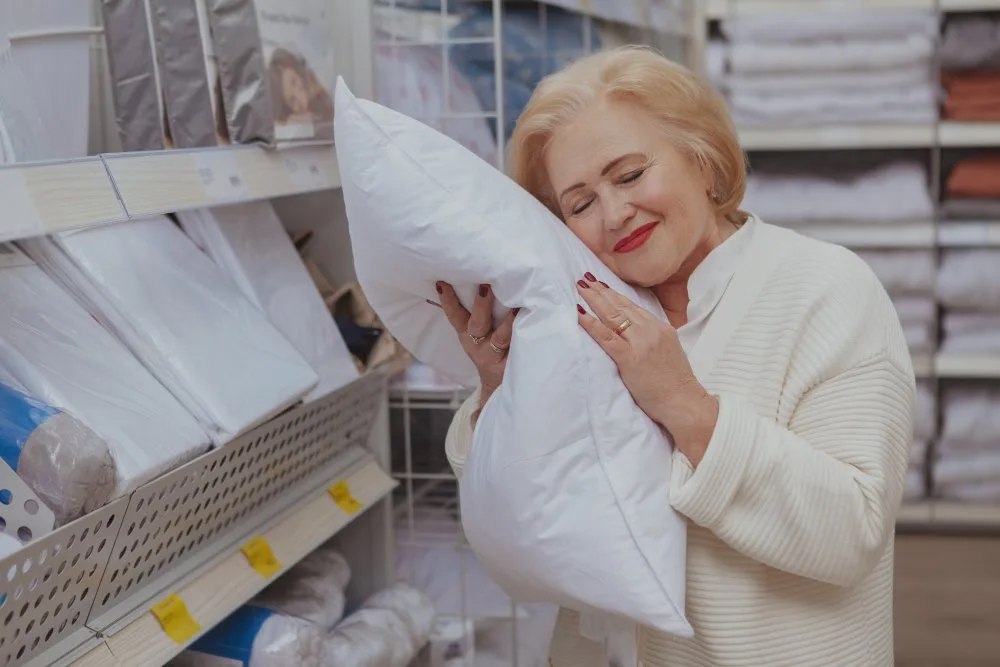
With silk’s high price, fake silk floods the market. Some sellers deliberately mislead customers, while others use confusing terminology. Here’s how to make sure you’re getting real mulberry silk.
How Can You Tell Fake Mulberry Silk?
1. Check the Label
Look for these specific terms:
- “100% Mulberry Silk” (this is what you want)
- Grade indication (6A, 5A, etc.)
- Momme weight (19-25mm for bedding) – use our guide to find the right weight
- Certifications (OEKO-TEX Standard 100, GOTS)
Red flags on labels:
- “Silk satin” without specifying mulberry silk (could be polyester satin)
- “Satin” or “silky” without the word silk (definitely not silk)
- “Silk blend” (mixed with synthetic fibers)
- No specific information about type of silk
2. The Burn Test
Real silk is protein-based, so it burns like hair. Take a small thread from a seam (not a visible area) and carefully burn it:
- Real Silk: Burns slowly, smells like burning hair, leaves dark ash that crumbles easily, flame goes out when removed from fire
- Polyester/Synthetic: Melts and drips, smells like burning plastic, leaves hard black beads, continues burning
Safety Warning
Only do the burn test if you’re comfortable with fire safety. Use tweezers to hold the thread, have water nearby, and do this over a sink or other non-flammable surface. Never do this test while wearing the item.
3. Price Reality Check
Real mulberry silk can’t be dirt cheap. Here’s what realistic pricing looks like:
- Pillowcases: $50-150 for quality 22mm mulberry silk
- Sheet Sets: $300-800 depending on size and momme
- Scarves: $30-100+ depending on size
- Fabric by the yard: $20-50+ per yard
If you find a “100% mulberry silk” pillowcase for $15, it’s either not real silk, very low grade, or misleadingly labeled. While sales and discounts happen, silk has real production costs that set a price floor.
4. Feel and Appearance
Real mulberry silk has specific characteristics you can check:
- Touch: Cool at first, then warms to body temperature. Smooth but not slippery like plastic. Has some weight to it.
- Shine: Subtle, natural luster that changes as light moves across it. Not harsh or plastic-looking.
- Color: White or cream-colored silk should have a pearl-like quality. Colors should look rich and even.
- Drape: Silk has beautiful drape and flows elegantly. It doesn’t stay stiff or hold a creased shape like some synthetics.
5. Brand Reputation
Buy from established brands with good reviews and return policies. Look for:
- Detailed product descriptions including grade and momme
- OEKO-TEX or other certifications
- Clear care instructions
- Good customer reviews (but watch for fake reviews)
- Transparent about sourcing
- Money-back guarantee or return policy
Is Mulberry Silk Legit?
Yes, mulberry silk is absolutely legitimate and represents the highest quality silk available. The term isn’t marketing hype. It refers to a specific type of silk from a specific silkworm species with measurable quality differences from other silks. However, not every product claiming to be mulberry silk actually is. That’s why learning to verify silk authenticity matters.
How to Tell If It’s Real Mulberry Silk
Beyond the tests above, here are additional checks:
- Rubbing Test: When you rub real silk quickly, it warms slightly and doesn’t make much noise. Synthetic satin makes a rustling sound and stays cool.
- Ring Test: Quality silk (not heavy-weight silk) should be able to pass through a ring. This tests the fineness of the fabric.
- Light Test: Hold silk up to light. Real silk has subtle irregularities because it’s a natural fiber. Perfectly uniform appearance might indicate synthetic material.
- Water Test: Real silk absorbs water. Put a small drop of water on the silk. It should be absorbed slowly. Polyester satin will bead up on the surface.
Is Mulberry Silk Worth the Investment?

This depends on your priorities and budget. Let’s break down the actual costs and benefits to help you decide.
The Real Cost of Mulberry Silk
A single quality mulberry silk pillowcase costs $70-100 on average. Seems expensive, right? But let’s look at the cost per use:
- Quality silk pillowcase: $80
- Expected lifespan with proper care: 3-5 years
- Nights of use: 1,095 nights (3 years)
- Cost per night: $0.07
Compare this to a regular cotton pillowcase at $15 that lasts 1-2 years. You’ll replace it more frequently and won’t get any of silk’s benefits for hair and skin. Over five years, you might spend $45-75 on cotton pillowcases while getting less benefit.
💰 Calculate Your True Silk Costs
Wondering if silk is really worth it for your budget? Our care cost calculator compares the lifetime costs of silk (including care) versus cotton and synthetic alternatives. See exactly how much you’ll spend over 5 years and whether the benefits justify the investment.
Calculate Real Costs →Why Is Mulberry Silk So Expensive?
The high cost reflects real production challenges:
- Labor Intensive: Silkworms must be fed fresh mulberry leaves 24/7 for weeks. Cocoons must be carefully harvested and processed by hand.
- Low Yield: It takes 2,000-3,000 cocoons to make just one pound of silk. That’s thousands of silkworms eating tons of leaves.
- Time Required: From egg to finished silk takes several months.
- Skill Needed: Proper silk reeling and weaving require expertise developed over years.
- Quality Grading: Only 5-10% of silk reaches 6A grade.
- Delicate Process: Mistakes in any step can ruin the silk or lower its quality.
Cheap “silk” products cut corners somewhere – lower grade silk, synthetic blends, or misleading labeling.
Who Should Invest in Mulberry Silk?
Mulberry silk is worth it if you:
- Have hair concerns (breakage, frizz, thinning, or are growing your hair)
- Have skin concerns (dryness, acne, sensitivity, or want to prevent wrinkles)
- Have allergies or asthma (silk’s hypoallergenic properties can help)
- Sleep hot or cold (silk’s temperature regulation helps)
- Value quality and durability over saving a few dollars
- Appreciate natural materials and sustainability
- Simply enjoy luxury and want the best sleep experience
Who Might Skip Silk?
Mulberry silk might not be for you if:
- Your budget is very tight (focus on necessities first)
- You don’t want to deal with special care requirements
- You’re fine with your current bedding and don’t have any concerns
- You have ethical concerns about traditional silk production
- You tend to be rough with your belongings
Making Silk More Affordable
If you want to try silk without a huge investment:
- Start with just one pillowcase (for the side you sleep on most)
- Choose 19mm instead of 22mm (slightly less expensive)
- Look for sales during holiday periods
- Buy from newer brands that price lower to build market share (but verify quality)
- Consider 5A grade instead of 6A (still high quality, slightly lower price)
- Skip the full sheet set and just get pillowcases first
Frequently Asked Questions
Can you machine wash mulberry silk?
Yes, you can machine wash mulberry silk using a delicate cycle with cold water (below 30°C/86°F). Place silk items in a mesh laundry bag, use gentle silk detergent without enzymes, and wash silk alone or only with other silk items. Remove immediately after the cycle and air dry. Never use the dryer. Hand washing is gentler and recommended for extending silk’s lifespan. For detailed care instructions specific to your silk item, try our silk care calculator.
What momme weight is best for silk pillowcases?
22 momme is ideal for silk pillowcases. This weight provides the perfect balance of durability, comfort, and luxury. 19 momme works well for a more affordable option, while 25-30 momme offers maximum durability and substantial feel for colder climates. Avoid anything below 16 momme for pillowcases as it won’t last as long with regular use.
How long does mulberry silk last?
Quality mulberry silk pillowcases and bedding typically last 3-5 years with proper care. Higher grades (6A, 5A) and higher momme weights (22mm+) last longer. Proper washing, avoiding heat, and gentle handling extend silk’s lifespan. Some people report their silk lasting 10+ years, though the fabric may show some wear by then. Regular cotton pillowcases typically last 1-2 years for comparison.
Is silk or satin better for your hair?
Real mulberry silk is significantly better than satin (polyester satin) for hair. Silk’s natural protein structure reduces friction more effectively, doesn’t absorb hair moisture like cotton, and its amino acids are compatible with hair structure. Polyester satin offers some friction reduction but lacks silk’s natural benefits, doesn’t regulate temperature as well, and can feel clammy. For maximum hair benefits, choose 100% mulberry silk.
Does silk help prevent wrinkles?
Silk may help reduce sleep creases and morning face lines due to its smooth, friction-free surface. Unlike cotton that can pull and crease skin, silk allows your face to glide smoothly across the pillowcase. The moisture-retention properties also help keep skin hydrated overnight. While silk won’t eliminate wrinkles, many people notice fewer morning face creases and smoother skin over time.
What’s the difference between charmeuse and habotai silk?
Charmeuse is a satin-weave silk with a shiny front and matte back, commonly used in bedding and luxury clothing. It has a heavier drape and more substantial feel. Habotai (also called China silk) is a plain-weave silk that’s lighter weight with a slight sheen on both sides. Charmeuse is typically preferred for pillowcases because of its smooth, lustrous surface and more durable feel.
Can you dye mulberry silk at home?
Yes, silk takes dye beautifully. Use acid dyes (like Jacquard or Dharma Trading) specifically made for protein fibers. Heat the dye bath to about 85°C (185°F), add silk, and simmer gently for 30-45 minutes. Rinse thoroughly with cool water and air dry. Test on a small piece first. Professional dyeing is recommended for expensive items or if you want guaranteed results.
Is peace silk as good as regular mulberry silk?
Peace silk (ahimsa silk) is ethically produced by allowing moths to emerge before harvesting cocoons, but it has different properties than regular mulberry silk. Peace silk fibers are shorter and less uniform, resulting in a less smooth texture, reduced sheen, and slightly rougher feel. It’s a good choice for ethical reasons but doesn’t offer the same luxury qualities. It’s also more expensive due to lower yields.
Why does my silk pillowcase feel different after washing?
Silk may feel slightly different after the first few washes as natural sericin residue is removed. This is normal. If silk feels rough or stiff, you may have used water that was too hot, the wrong detergent, or too much detergent. Re-wash with proper silk detergent and cool water. If the change is dramatic, heat damage or harsh chemicals may have permanently altered the fibers.
Can babies sleep on mulberry silk?
Quality mulberry silk (with OEKO-TEX certification) is safe for babies and children. Silk’s hypoallergenic, breathable, and temperature-regulating properties can be beneficial. However, for infant sleep safety, always follow AAA recommendations: babies should sleep on a firm, flat surface without loose bedding or pillows until at least 12 months. Silk pillowcases are appropriate for older children.
Conclusion
After reading this complete guide, you now understand that mulberry silk isn’t just marketing hype. It’s a natural fiber with unique properties that have made it the world’s most luxurious fabric for over 5,000 years. The smooth protein structure, hypoallergenic nature, temperature regulation, and hair and skin benefits are real advantages backed by the material’s composition.
However, mulberry silk also requires honest acknowledgment of its drawbacks. The high cost, special care requirements, and ethical concerns about traditional production methods mean silk isn’t automatically the right choice for everyone. Your decision should depend on your specific needs, values, and budget.
Key Takeaways
- Quality Matters: Look for 6A or 5A grade mulberry silk at 19-25 momme weight. These specifications ensure you’re getting silk that will actually deliver the promised benefits and last for years.
- Verify Authenticity: With the prevalence of fake silk, use the burn test, check prices realistically, and buy from reputable sources with certifications like OEKO-TEX Standard 100.
- Care Is Simple But Non-Negotiable: Wash with cool water and gentle detergent, never use heat, and air dry only. These basic rules make the difference between silk that lasts years and silk that’s ruined in months.
- Start Small: If you’re unsure about the investment, begin with one silk pillowcase. This lets you experience the benefits for your hair and skin without the full cost of complete bedding.
- Consider Your Priorities: Silk excels at specific things: hair protection, skin care, allergy reduction, and temperature regulation. If these matter to you, silk is worth every penny. If you’re happy with regular bedding and don’t have any concerns, you might not notice enough difference to justify the cost.
- Look Beyond Price: Calculate cost per use over the item’s lifespan. Quality silk that lasts 5 years offers better value than cheap alternatives replaced every year.
- Sustainability Is Complex: Silk has environmental advantages (biodegradable, low water use) and concerns (silkworm treatment, carbon footprint). Research brands committed to sustainable practices if this matters to you.
Final Recommendations
If you have hair concerns, skin sensitivity, or allergies, we recommend investing in at least one 22mm, 6A grade mulberry silk pillowcase from a certified brand. The difference in your hair and skin can be noticeable within weeks, and the improved sleep quality often surprises people. Not sure which momme weight to choose? Check out our momme weight guide for personalized recommendations.
For those prioritizing sustainability, look for GOTS-certified organic silk or consider peace silk despite its different texture. If budget is tight, one quality silk pillowcase provides more benefit than a full set of lower-grade silk. Use our care cost calculator to see exactly how silk fits your budget over time.
Remember that silk is an investment in both luxury and self-care. It’s not frivolous to spend money on something that affects your daily comfort and potentially your hair and skin health. Just make sure you’re buying real, quality mulberry silk and caring for it properly to get your money’s worth.
Whether you decide silk is right for you or not, you now have the knowledge to make an informed decision. You understand what makes mulberry silk special, how to evaluate quality, how to care for it, and what realistic expectations should be. That’s worth more than any sales pitch.
Ready to explore more about different fabric types? Check out our comprehensive guides on natural versus synthetic fabrics to help you make the best choices for your needs.

